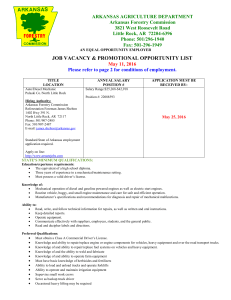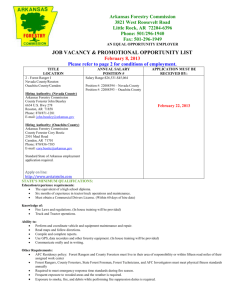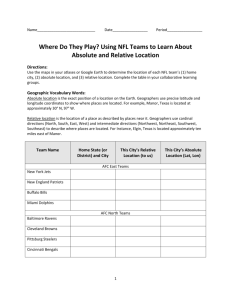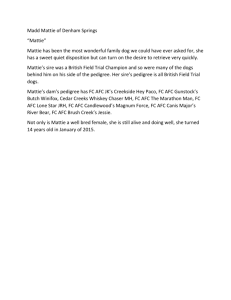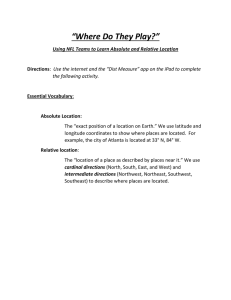Document 11863967
advertisement
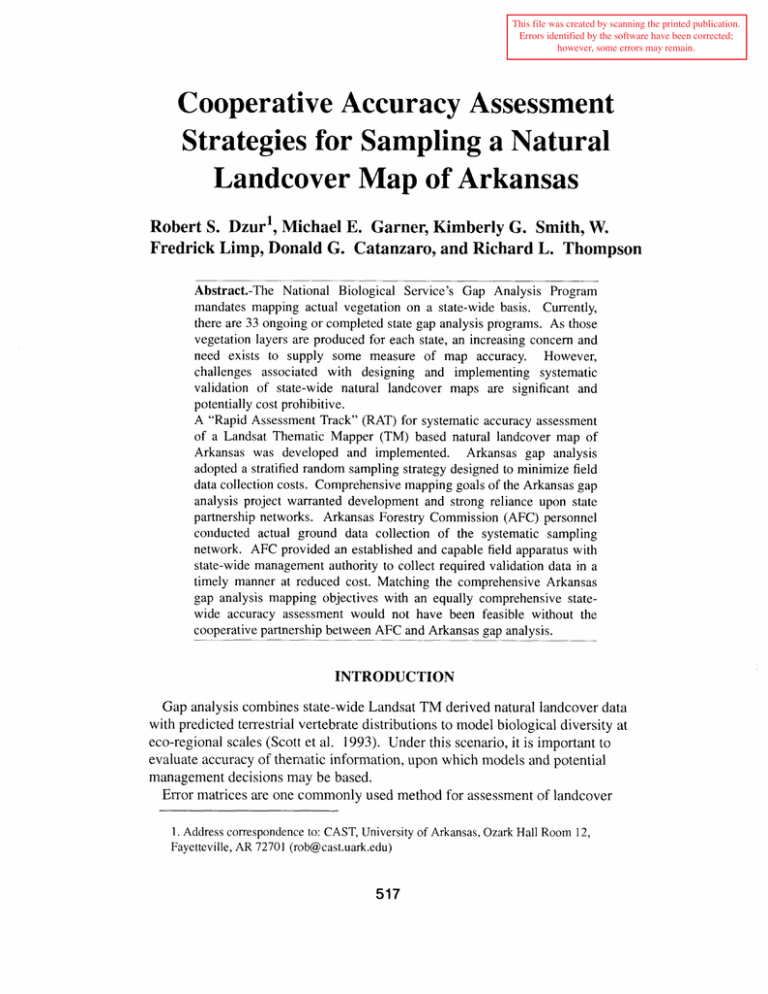
This file was created by scanning the printed publication. Errors identified by the software have been corrected; however, some errors may remain. Cooperative Accuracy Assessment Strategies for Sampling a Natural Landcover Map of Arkansas Robert S. ~ z u r ' ,Michael E. Garner, Kimberly G. Smith, W. Fredrick Limp, Donald G. Catanzaro, and Richard L. Thompson Abstract.-The National Biological Service's Gap Analysis Program mandates mapping actual vegetation on a state-wide basis. Currently, there are 33 ongoing or completed state gap analysis programs. As those vegetation layers are produced for each state, an increasing concern and need exists to supply some measure of map accuracy. However, challenges associated with designing and implementing systematic validation of state-wide natural landcover maps are significant and potentially cost prohibitive. A "Rapid Assessment Track" (RAT) for systematic accuracy assessment of a Landsat Thematic Mapper (TM) based natural landcover map of Arkansas was developed and implemented. Arkansas gap analysis adopted a stratified random sampling strategy designed to minimize field data collection costs. Comprehensive mapping goals of the Arkansas gap analysis project warranted development and strong reliance upon state partnership networks. Arkansas Forestry Commission (AFC) personnel coiiducted actual ground data collection of the systematic sampling network. AFC provided an established and capable field apparatus with state-wide management authority to collect required validation data in a timely manner at reduced cost. Matching the comprehensive Arkansas gap analysis mapping objectives with an equally comprehensive statewide accuracy assessment would not have been feasible without the cooperative partnership between AFC and Arkansas gap analysis. INTRODUCTION Gap analysis combines state-wide Landsat TM derived natural landcover data with predicted terrestrial vertebrate distributions to model biological diversity at eco-regional scales (Scott et al. 1993). Under this scenario, it is important to evaluate accuracy of thematic information, upon which models and potential management decisions may be based. Error matrices are one commonly used method for assessment of landcover 1. Address correspondence to: CAST, University of Arkansas, Ozark Hall Room 12, Fayetteville, AR 72701 (rob@cast.uark.edu) maps produced by analysis of remotely-sensed digital multispectral satellite data (Congalton 1988, Lark 1995, Verbyla and Hammond 1995). The error matrix is a two-way contingency table that compares classified pixels to a set of independently collected reference data (Janssen and van der We1 1994). Collecting unbiased independent reference samples across a 13,798,200 ha study area such as Arkansas becomes problematic. Because of their size, statewide natural landcover maps offer many difficult logistical issues for systematic thematic accuracy assessments. Among these issues are limited access to private lands, time, and cost constraints. These broad issues characterize the problem of implementing an accuracy assessment on a state-wide scale. While those issues are readily apparent and relatively easy to isolate, the challenge remains to devise available options that address those broad constraints. The Arkansas gap analysis project required an implementation plan - a "Rapid Assessment Track" (RAT) - for gap analysis landcover map accuracy assessment that minimized direct data collection time, costs, and land access limitations. Perhaps the most influential factor on the magnitude of logistical obstacles lies in the character of the sample design used for accuracy assessment. Janssen and van der We1 (1994) suggested that poor accessibility and limited budgets may result in a cluster-based sampling approach. While clustered sampling might reduce the cost to travel between sample units, field crews still needed to visit and record sample site information. Field crews for accuracy assessment were solicited from Arkansas gap analysis cooperators gathered at the third annual statewide gap analysis meeting in February of 1995 in Little Rock (Dzur et al. In press). Here, Arkansas Forestry Commission (AFC) demonstrated a willingness to participate in the RAT initiative. As the state agency responsible for the protection and development of Arkansas' forest resources, AFC possessed key qualities needed to implement RAT. AFC provided a well-developed organizational structure. Furthermore, AFC provided a knowledgable and well-equipped (vehicles, etc.) personnel base trained in land navigation and natural landcover recognition. This state-wide personnel network facilitated simultaneous sample data collection across the entire state, thus minimizing collection time. This paper presents development of cooperative implementation strategies for systematic accuracy assessment of a natural landcover map of Arkansas. Research objectives described include: automated sample design development and automated field material production directed toward realization of a simple, systematic, and cost effective state-wide accuracy assessment approach that relied upon an established partnership between the Center for Advanced Spatial Technologies (CAST) and AFC. METHODS RAT operational viability resulted from a carefully devised methodology related to sample design and field material composition. Sample Site Selection A critical RAT objective was to employ random sampling at clustered locations. This objective framed another compelling reason to involve AFC in the sampling effort. Commanding state-wide presence and authority, AFC field crews gained ready access to lands otherwise inaccessible due to the geography of land ownership. AFC participation helped enable a random site selection design. Site Selection Processing Sample point selection methods were adopted and modified from Utah gap analysis (Edwards et al. 1995). Arkansas gap analysis spectral classification procedures utilized National Resource Conservation Service (NRCS) State Soil Geographic Data Base (STATSGO) for stratification of spectral space. Accordingly, RAT sampling was stratified by major landforms of Arkansas (figure 1). U. S. Geological Survey (USGS) 7.5 minute quadrangles served as the first filtering strata for the clustering of random samples. A total of 100 USGS 7.5 minute quadrangles (figure 2) were randomly selected in proportion to the relative area of Arkansas' 10 major landforms. For example, since the Arkansas River Valley and Ridge landform region comprised 10% of the state, this region was randomly assigned 10 quadrangles. Once identified, quadrangles were further subdivided into two road-based strata within which a total of 20 1-ha sample points per quadrangle were distributed. Each quadrangle was buffered by 360 m to ensure that roads on surrounding quadrangles did not influence random site selection. Then, the 1:100,000 scale USGS Digital Line Graph (DLG) road network was buffered by 300 m. Within this buffer zone, 10 sites were randomly selected. Next, 10 additional sites were systematically located adjacent to one another based upon a single randomly placed starting point selected outside the roads buffer. These 10 off-road sites were positioned so as not to touch the roads buffer and to lie on a 1 km transect oriented north for easy compass location by the ground crew. A GRASS GIs UNIX script automated random site selection processing for the 100 quadrangles. Field Material While AFC provided the labor force required to visit those sample sites, CAST needed to ensure a quality data collection effort. Accurately locating sample points in the field was the central concern and most difficult expectation. Since it was impractical to equip AFC with Global Positioning System (GPS) equipment, an alternative was to provide AFC crews with clearly delineated and detailed field map sheets. Designing the most effective field map for AFC personnel required intimate understanding of AFC land navigation training guidelines. AFC outlined these guidelines and recommended a ranked priority of routine AFC land reference features for inclusion on field maps. Since the chain (20 m) is the fundamental unit of field measurement used by AFC personnel, AFC requested a chain map scale. In keeping with AFC needs, maps were printed with a mile barscale subdivided by tenths (80 chains = 1 mile). According to AFC, Public Land Survey System (PLSS) line work was an absolute requirement. Once PLSS data became available from USGS, CAST manufactured a field data collection package complete with detailed field maps, map classification keys, and disposable cameras. Field Map Production Two sets of 8.5 x 11 field maps (one color and one black and white) were automatically generated for each quadrangle using the Interactive Mapper (www.cast.uark.eduiproducts/MAPPERl) GRASS script modified to print field map specific features. Distinct color, weight, and style symbology were used to maximize contrast between map features. Separate background raster maps were rendered for color and black and white maps. A Landsat TM unsupervised classification with tasseled-cap (Crist and Cicone 1984) pseudo color table (RGB equals wetness, greenness, brightness) was used as the background raster for color maps. Figure 3, for example, depicts the landscapes of the St. Francis National Forest (upper right) on Crowley's Ridge and the Mississippi alluvial valley. Topologically Integrated Geographic Encoding and Referencing System (TIGER) water was used as the background raster layer for black and white maps (figure 4). Numerous 1: 100,000 scale reference layers were then printed over the raster background. These reference layers appeared on both map sets and included: TIGER roads (with varying line weights and styles for distinct road classes), TIGER railroads, DLG hydrology, DLG contours, and DLG PLSS data (with labelled sections). USGS Geographic Names Information System (GNIS) populated place names and their site locations were printed and oriented such that the names would always be contained entirely within the map area. A white dot surrounded by a black ring marked the 20 sites obtained from the site selection procedure. Sites were given an alphabetical (A-K) letter designation from north to south where K always indicated the 1 km transect. Margin information contained barscale, state locator map, north arrow, quadrangle name and unique number identifier, regional coverage (LatitudeiLongitude), source data, and CAST contact information. A total of 300 (200 color, 100 black and white) maps were delivered to AFC. One set of color maps was maintained at AFC headquarters in Little Rock, AR. The remaining maps were bundled by AFC district for distribution to district foresters and then to actual field crews. To avoid potential bias in data collection, Figure 3. Color field map. WEST HELENA Quadcode 579 )el M q AR.wslsnh.TIGER >at= k s u s TIGER R& Fg:L&&Cp?6mWd%T7 0 1 H H H t 1 1 MILES Somars. GRASS WS. Unlr Rwm v M SpUII T ~ h h d m o f ~ r k e r s sF cnmlc s 7 5 6 d i %51d218 %?a lo M Jna- +me. LO 8 N 343';4Eb?% $E$%~~%?~~s i Figure 4. Black and white field map. no explanation or meaning was attributed to the pattern of color portrayed by the Landsat TM background layer. The black and white map doubled as field data sheet. On the reverse of this map were 20 data entry rows beginning with sample site A. Data entry columns included: date, landcover code, photo #, source, and comments. While on-site visits were preferred, it was recognized that some sites may have been previously inventoried. Therefore, the source column listed three data survey alternatives: on-site visit (V), inventory records (I), or personal communication (P). At the top of the field data sheet, name and phone number of the field observer were recorded. Upon RAT completion, black and white map/ field data sheets were returned to CAST. Classification Key Development A UNESCOITNC based vegetation classification scheme was adopted for Arkansas gap analysis landcover mapping (Foti et al. 1994). The UNESCOITNC classification system is characterized by its hierarchical structure (Jennings 1993). To help field crews match ground data to this classification system a coded semidichotomous key was assembled from the classification system (figure 5). The key was designed to lead the user through a possible 35 main entries with multiple contrasting sub-entries defining particular landcover criteria to identify the correct landcover map class. Flowing linearly in accordance with the hierarchical structure of the UNESCO based classification, the key first delineates class membership at a system level (e.g., Terrestrial, Developed Cover, Palustrine, Riverine, etc.). The two-page (double-sided) key reads from left to right starting CODE DEFINITION Primarily water (bottomlands) primarily land . Primarily altered by humans Long term to permanent flooding. Seasonal flooding (short to long duration). Streamside areas and channels. Wetlands and deep water habitat. 30% tree coverage lacking trees and shrubs. Total area usually > 20 acres. GAP CLASS GO TO 2 TERRESTRIAL 4 URBAN/AGRI/REGEN 35 3 PALUSTRINE 23 RIVERINE 32 LACUSTRINE 34 TERRESTRIAL Areas dominated by trees with a total canopy cover of 61 % or more, tree crowns usually interlocking. FOREST Areas dominated by trees with a total canopy cover of 26-60%, most tree crowns not touching each other. An herbaceous or shrub understory, or both are usually present. WOODLAND Areas dominated by shrubs that generally exceed 0.5 meters in height when mature with a total canopy cover of 26% or more. A tree canopy cover of 26% or less may be present. SHRUBLAND Areas dominated by grass, grass-like, or forb vegetation with a tree or shrub component not exceeding 26% cover. GRASSLAND Areas where vegetation cover is less than 5%. BARE Mainly evergreen forest (> than 75% evergreen trees) Mainly deciduous or mixed (25% - 75% evergreen trees) Dominated by eastern redcedar (Juniperus virginiana) Dominated by pines Shortleaf pine (Pinus echinata) dominant Loblolly pine (Pinus taeda) dominant Mixed shortleaf pine - loblolly pine (sometimes hickory) T.l.a.9.c.I T.l.A.9.b.111 Figure 5. Example page from Arkansas gap analysis classification key. 5 15 17 18 22 with landcover code, followed by a code description, the equivalent gap analysis classification notation (e.g., T.l .A.9.b.I - Pinus echinata), and finally a "Go To" column with a number designating the next step down the hierarchy toward a level five (cover type) classification. To locate shortleaf pine (Pinus echinata) dominated forest with the key, for example, AFC field personnel start with code 1a. As 1a - "primarily water (bottomlands)" does not apply, proceeding to l b - "primarily land" satisfies the present conditions and points to 4. The first entry (4a), "areas dominated by trees with a total canopy cover of 61 % or more, tree crowns usually interlocking", fits the definition of forest leading the search to 5. Again the first entry (5a), "mainly evergreen forest (> than 75% evergreen trees)", corresponds to ground evidence and leads to 6. As 6a, "dominated by eastern redcedar (Juniperus virginiana)", does not agree, the next alternative, (6b), "dominated by pines", leads to 7 where 7a, "Shortleaf pine (Pinus echinata) dominant", matches the site characteristics. Then, 7a was recorded on the field data sheet. Instructions to field crews were to record the code about which they had the most confidence. Site Verification and Pictorial Key Concept When landcover codes were listed on the field data sheet, a fundamental question remained. What did Pinus echinata (7a) look like? Since data were collected by AFC field crews rather than CAST staff, site characteristics were essentially unknown. To supplement the recorded codes, 25 of the 100 sample quadrangles were arbitrarily allocated a disposable Kodak Fun Camera. At least 2 quadrangles in each major landform unit were assigned cameras. For each sample location, field crews took one picture (figure 6) that best captured the landcover code and recorded the corresponding exDosure number in the ~ h o t #o column. with pictorial examples of landcover map categories using ground based photos, aerial videography frames, and satellite imagery. RESULTS A total of 90 field data sheets (quadrangles) were returned. From those quadrangles, AFC collected a total of 1777 field sample points. Two quadrangles lacked the off-road points because they were not printed on the field maps. Only 3 sites were not collected because the landowner would not allow the AFC crew to enter the property. Of the total sample sites, 1601 were actual on-site visits, 156 were based on inventory records, and 20 were based on personal communication. A total of 23 cameras were returned. From those cameras, 412 photos were developed. Although every roll was not completely developed, most photos appeared very informative. Even underexposed photos provided informational clues related to canopy closure. Expected benefit relative to a total cost of $330 for camera purchase and film developing justified the experimental camera concept. CONCLUSIONS RAT'S primary accomplishment was implementing a cooperative state-wide systematic data collection effort. As noted in the methods section, two major elements guided successful RAT implementation. First, the sample design achieved immediate reductions in data collection time through stratification on quadrangles and roads. Second, clear and concise field materials supported AFC field observations. Field materials were generated to assist sample site location, description, and documentation. Furthermore, field materials formed the vital link between sample design and field data collection. As potential users of the Arkansas natural landcover map, AFC recognized legitimate value in RAT objectives and contributed a proportional commitment to the successful completion of RAT. Although AFC's participation in RAT minimized direct costs to the Arkansas gap analysis project, AFC costs were not minimal. In fact, Robert McFarland, AFC Assistant State Forester, estimated manpower costs alone at one half man year (over $10,000). Still, RAT demonstrated that partnerships strengthened by well-developed planning can overcome major impediments to state-wide accuracy assessment of land access, collection time, and cost. ACKNOWLEDGMENTS The described assessment technique was funded through grants from the United States Fish and Wildlife Service, Award #l4-l6-OOO9-l567 RWO #13, as a part of the National Gap Analysis Program, and the National Aeronautics and Space Administration, Award # NAGW-4117 with voluntary contributions from AFC. CAST is appreciative of all AFC field crews that participated in this project. Thanks is due to Robert McFarland (AFC Assistant State Forester) and J. Gamer Bamum (AFC Assistant State Forester) for coordinating RAT at AFC and contributing their thorough insight of AFC operations to RAT planning. REFERENCES Congalton, C.G. 1988. A comparison of sampling schemes used in generating error matrices for assessing the accuracy of maps generated from remotely sensed data. Photogrammetric Engineering and Remote Sensing, 54: 593-600. Crist, E.P. and R.C. Cicone. 1984. A physically-based transformation of Thematic Mapper data - The TM Tasseled Cap. IEEE Transactions on Geoscience and Remote Sensing GE-22: 256 - 263. Dzur, R.S., M.E. Gamer, K.G. Smith, and W.F. Limp. In press. Gap Analysis partnerships for mapping the vegetation of Arkansas. In J.M. Scott, T.H. Tear, and F. Davis, eds. Gap Analysis: A landscape approach to biodiversity planning. American Society for Photogrammetry and Remote Sensing, Bethesda, Maryland. Edwards, T.C. Jr., C.G. Homer, S.D. Bassett, A. Falconer, R.D. Ramsey, and D.W. Wight. 1995. Utah Gap Analysis: An environmental information system. Final Project Report 95-1. Utah Cooperative Fish and Wildlife Research Unit. Utah State University, Logan, UT 84322-52 10. Foti, T., X. Li, M. Blaney, and K.G. Smith. 1994. A classification system for the natural vegetation of Arkansas. Proceedings Arkansas Academy of Sciences, 48: 50-62. Janssen, L L.F., and F.J.M. van der Wel. 1994. Accuracy assessment of satellite derived land-cover data: A review. Photogrammetric Engineering and Remote Sensing, 60: 41 9-426. Jennings, M.D. 1993. Natural terrestrial cover classification: assumptions and definitions. Gap Analysis Technical Bulletin 2. U.S. Fish and Wildlife Service, Idaho Cooperative Fish and Wildlife Unit, University of Idaho, Moscow. Scott, J.M, F. Davis, B. Csuti, R. Noss, B. Butterfield, C. Groves, H. Anderson, S. Caicco, F. D'Erchia, T.C. Edwards Jr., J. Ulliman, and R.G. Wright. 1993. Gap Analysis: a geographic approach to protection of biological diversity. Wildlife Monographs 123: 1 - 41. Verbyla, D.L., and T.O. Hammond. 1995. Conservative bias in classification accuracy assessment due to pixel-by-pixel comparison of classified images with reference grids. International Journal of Remote Sensing, 16: 58 1-587. BIOGRAPHICAL SKETCH Robert S. Dzur is Project Leader for the National Gap Analysis project in Arkansas. He graduated from the University of Arkansas in 1991 with a B.A. double major in Spanish and Geography and received an M.A. in Geography from the University of Arkansas in 1994. His research interests include applications of remote sensing1GIS to scale and spatial dependency of vegetation and landform relationships.
